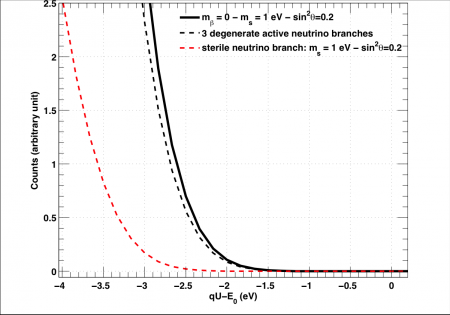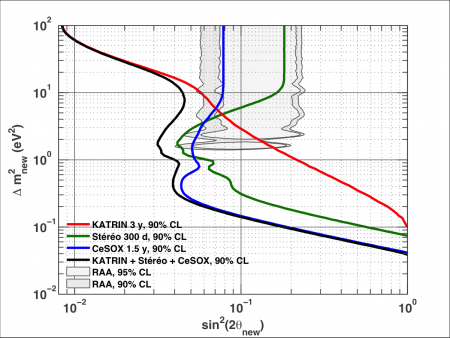
Light sterile neutrino branch (red) contributing to the observable tritium beta decay spectrum, near the endpoint energy of 18.575 keV. Credit: T. Lasserre.
Light sterile neutrinos: physics case
The majority of neutrino oscillation results are explained by the three-neutrino formalism. But a bunch of anomalies in short baseline oscillation data can be interpreted by invoking a fourth neutrino. This new state would be separated from the three standard neutrinos by a squared mass difference ?m2 of 0.1 − 1 eV2 and would have mixing angles of sin22θe4 > 0.01.
As designed the KATRIN experiment can probe part of the current allowed region of the reactor antineutrino anomaly, especially for ?m2 greater than a few eV2 , with 3 years of data-taking. First results are expected in 2017. The CEA group is involved in the search for light sterile neutrino (simulation and analysis).
Light Sterile Neutrinos: simulation
A new simulation package has been developped at CEA for studying the sensitivity of KATRIN to search for light sterile neutrinos. Eventually this work could contribute to an optimization of the eV-sterile neutrino search.
Beyond the computation of the statistical sensitivity, including backgrounds, we include a full treatment of correlated detector systematics using the Multisim approach. This method allows to translate a set of correlated variables and their uncertainties, from the theory and the apparatus, to the KATRIN observable, the tail of tritium β-decay spectrum. As a result we obtain the central-valued tritium β-decay spectrum and the covariance matrix of uncertainties.
As an example we show here the KATRIN response function and its uncertainties. It describes the probability of tritium electrons of a specific energy to be detected as function of the retarding voltage at the spectrometer. This computation takes into account all possible source and transport related energy losses, as well as the transmission characteristics of the main spectrometer.

Simulation of the expected sensitivity of KATRIN for searching light sterile neutrinos (red) and combination with the CeSOX and Stéréo experiments.Credit: T. Lasserre.
Light Sterile Neutrinos: combination with CeSOX and Stéréo
KATRIN is part of a worldwide program searching for light sterile neutrinos. Among the other experiments we consider here:
- CeSOX that consists in bringing close to the Borexino detector a 5 PBq 144Ce-based antineutrino generator and let it in place, without manipulation for a period of ≈ 1.5 year. The existence of a 4th neutrino will manifest itself as a periodic modulation in the recorded distribution of the rare neutrino interactions inside the fiducial volume.
- Stéréo that consists in constructing a electron antineutrino detector close to the ILL research nuclear core, for 300 days (reactor ON). A distrosion of the energy spectrum observed as a function of the baseline would sign the existence of a light sterile neutrino.
We find that KATRIN's sensitivity superceeds CeSOX and Stéréo for Δm2 > 4 eV2. At lower Δm2 the KATRIN sensitivity is mainly limited by backgrounds as well as statistics. In addition we study the combination of the expected sensitivities of CeSOX, Stéréo, and KATRIN. If no signal is reported, the combination would exclude the whole gallium and reactor anomalies region of interest at a confidence level greater than 99%.
Ressources:
- Talk on light sterile neutrinos ICT* Trento workshop, Trento, April 2016
- Talk at the IAS General Assembly on sterile neutrinos, Munich, March 2016
- Talk on the searches for light sterile neutrinos with Source Experiments, Pittsburgh, January 2016
- Talk on light sterile neutrino search, Challonge Workshop 2015, June 2015


